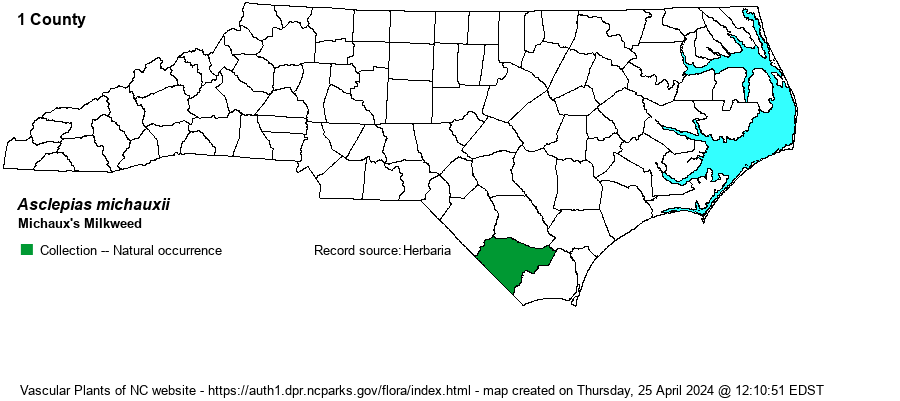| Author | Decaisne | |
| Distribution | A single record for Columbus County, in the southeastern corner of the state. Oddly, this species was collected on June 24, 1961, with the specimen in the NCU collection, but the specimen and species was not included for NC on the RAB (1968) map or text as occurring in NC -- because it was annotated to A. longifolia, despite the fact that one of the authors (Ahles) was the collector! In recent years, the specimen was re-examined, though it was annotated to Asclepias cinerea; it was re-annotated to A. michauxii in 2022! (Imagine -- one single collection of a milkweed was annotated and re-annotated to THREE species of this genus, normally not a troubling genus.)
It ranges from extreme southeastern NC (at least formerly) south to peninsular FL, and west to eastern LA.
| |
| Abundance | Historical now, and obviously was always extremely rare, with just the single collection from 1961. Note that "Asclepias cinerea" was listed as a State Special Concern - Historical species, in 2021. The editors recommend that this legal designation be corrected to A. michauxii; in the interim, the NCNHP should consider it as Significantly Rare. | |
| Habitat | This is one of a handful of milkweeds that grow primarily in pine savannas. As such, it favors high-quality sites that are frequently managed by prescribed fire. | |
| Phenology | Blooms primarily in May, and fruits shortly thereafter, into June at least. | |
| Identification | This is a rather short yet slender milkweed, often growing just to 1 foot tall or slightly taller, unbranched or branching once at the base. It has numerous linear leaves, opposite or sub-opposite, about 3-5 inches long but only 3-6 mm wide. It has just a single small flower head, terminal on the stem; about 1.5 inches across. The flowers are greenish white but with dark rose on the corona and back of the petals -- giving an odd mix of colors on the tight ball of flowers. As such, it most resembles A. longifolia, a somewhat taller plant that has its several flower clusters from upper leaf axils. The NC specimen had been confused with A. cinerea owing to a lack of flowers but just one or a few seed pods; that species has only several pairs of extremely narrow linear leaves that are clearly opposite, and mostly has its very open pink-lavender flower clusters from leaf axils. | |
| Taxonomic Comments | None
| |
| Other Common Name(s) | None | |
| State Rank | SH | |
| Global Rank | G4G5 | |
| State Status | SR-D | |
| US Status | | |
| USACE-agcp | | |
| USACE-emp | | |

